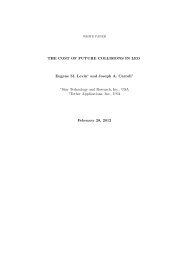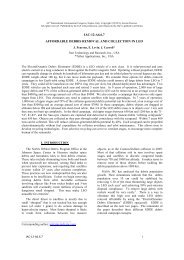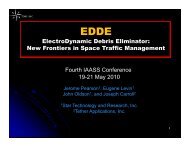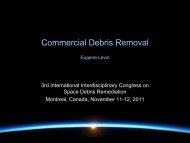IAF 04 Paper - Star Technology and Research
IAF 04 Paper - Star Technology and Research
IAF 04 Paper - Star Technology and Research
You also want an ePaper? Increase the reach of your titles
YUMPU automatically turns print PDFs into web optimized ePapers that Google loves.
His ideas appeared in a Sunday<br />
supplement to Pravda in 1960 2 , <strong>and</strong><br />
their significance was not recognized in<br />
the West. In 1966, a group of<br />
oceanographers led by John Isaacs at<br />
the Scripps Institute re-discovered the<br />
concept, but they proposed such a thin<br />
wire that it would be cut by micrometeoroids<br />
almost instantly, could not<br />
be scaled up, <strong>and</strong> was therefore<br />
completely impractical 3 .<br />
Jerome Pearson discovered the concept<br />
independently <strong>and</strong> published it in the<br />
international journal Acta Astronautica,<br />
<strong>and</strong> thus made the international<br />
aerospace community aware of the<br />
space elevator for the first time 4 , in<br />
1975. An Air Force painting of<br />
Pearson’s space elevator (Fig. 1) shows<br />
Fig. 1: The Space Elevator<br />
capsules moving up <strong>and</strong> down from the<br />
space complex in synchronous orbit.<br />
His discovery included using the space<br />
elevator for zero-net-energy space<br />
launching, <strong>and</strong> for launching payloads<br />
from the elevator tip to reach other<br />
planets without requiring rockets. He<br />
also was first to examine the dynamics<br />
of actually lifting payloads up the<br />
elevator, <strong>and</strong> found limitations on the<br />
speeds of ascent, akin to the critical<br />
velocities of a rotating shaft <strong>and</strong> the<br />
periodic loads from soldiers marching on<br />
a bridge. After talking with Pearson, the<br />
science fiction writer <strong>and</strong> visionary<br />
Arthur Clarke wrote his famous novel<br />
about the space elevator 5 .<br />
Pearson later extended the space<br />
elevator idea to the moon, using the<br />
Lagrangian points as balance points in<br />
lieu of the geostationary orbit, <strong>and</strong><br />
discovered that such a “lunar anchored<br />
satellite” 6 could be used to bring lunar<br />
materials into high Earth orbit cheaply.<br />
Fig. 2 shows an Air Force artist’s<br />
concept of the lunar anchored satellite<br />
with a spacecraft anchored beyond the<br />
L2 Lagrangian point on the far side of<br />
the moon, for communication with a<br />
farside astronomical observatory.<br />
Fig. 2: The L2 Lunar Space Elevator<br />
Interestingly, Artsutanov 7 published a<br />
paper on a lunar space elevator just one<br />
month later than Pearson, without either<br />
author being aware of the other! To<br />
compound the mutual lack of<br />
awareness, Levin points out that the<br />
Russian scientist Ts<strong>and</strong>er conceived of<br />
a lunar space tower 8 in 1910, although<br />
the ideas were not published until 1978.<br />
2








